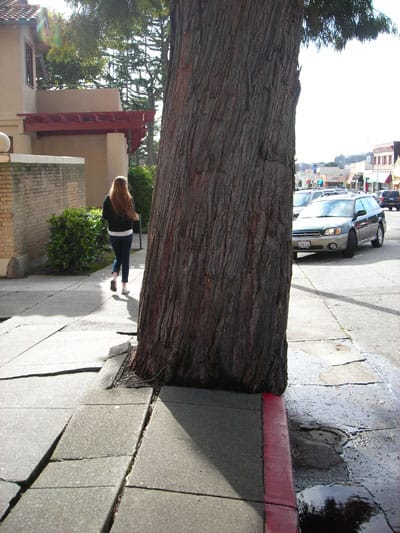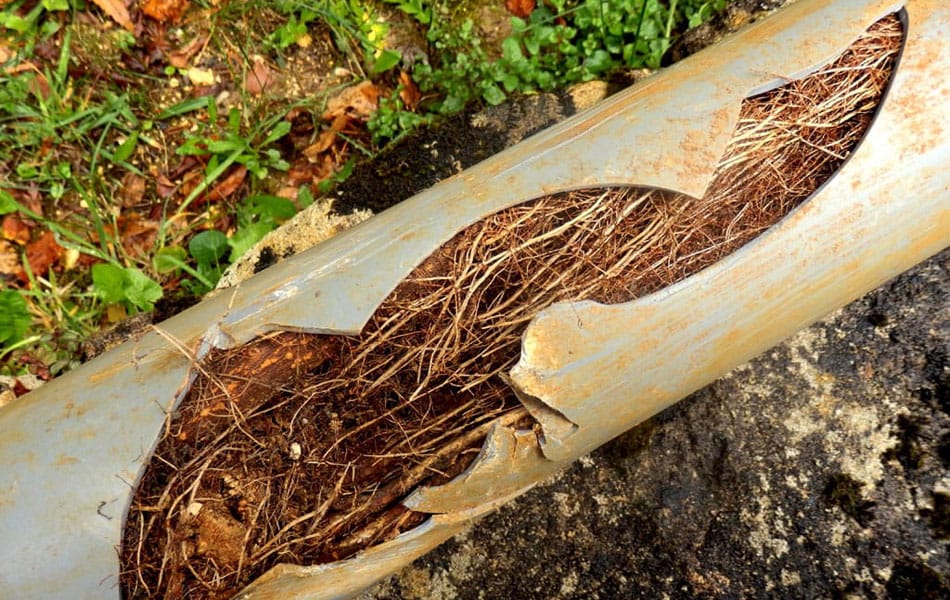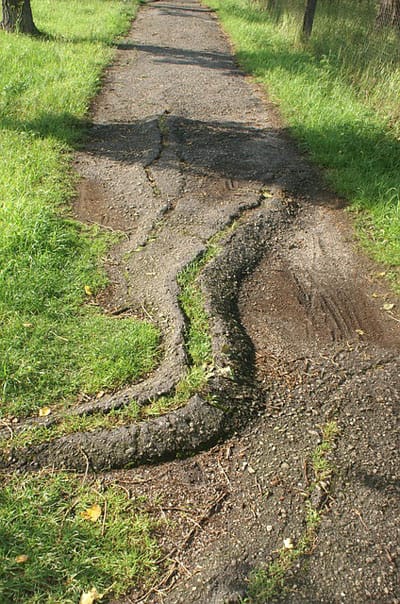Tree root problems can cause extensive damage, especially if you have trees growing near structures like foundations, underground pipes, or sidewalks. In many cases, you’ll find conflicts between those structures and your trees’ root system.
But while you can’t change a tree’s mind about where its roots want to grow, there are things you can do to prevent tree roots from becoming a major problem.
First Things First
Don’t blame your tree. Trees aren’t hatching plans to interfere with your sidewalks, patios, foundation, sewer lines, neighbors, or lawns!
In its natural setting, a tree grows where its roots or seeds create it. Forest trees live or die according to their surrounding conditions, as well as from competition for resources with neighboring trees.
Urban settings are different.
In a residential or commercial landscape, each tree is deliberately selected for planting. In this case, it’s the person who chooses the tree and decides where to plant it who must bear responsibility for many of the tree root problems that can result.
What Could Go Wrong with Tree Roots?
So, so many things can go wrong, especially when a tree is planted in the wrong spot!
Urban (and suburban) trees have a hard time right from the beginning. Many homeowners want trees on their property, many cities require them to be planted in public spaces, and more and more people are becoming aware of the great value that trees provide to our environment. Unfortunately, urban trees are often neglected or planted in locations where root problems are almost assured.
Below are some of the common areas where tree roots can cause serious problems.
Sidewalks, Patios, and Driveways
 Street trees and sidewalks are among the most commonly recognized odd couples. They’re both considered beneficial and are often required to be together. But while tree roots will win the battle against concrete sidewalks (or any nearby paved area), concrete wins the war.
Street trees and sidewalks are among the most commonly recognized odd couples. They’re both considered beneficial and are often required to be together. But while tree roots will win the battle against concrete sidewalks (or any nearby paved area), concrete wins the war.
As a tree grows, its trunk expands in diameter and its root system does too. There’s a natural growth pattern that happens on every tree, called “trunk flare” or “root flare.” This is where the base of the trunk and the top “shoulders” of the root system expand, often rising up as they do.
When this happens to a tree in a planting cut-out that’s too small or one that’s growing too close to a sidewalk, its ever-expanding roots push up against the concrete or paved sidewalk. The trunk may also expand in girth to a point where it takes up the entire cut-out and, with nowhere to go, strangle itself.
Concrete is a strong but brittle, unbending material. Because of its rigidity, it is scored or divided into small areas to control its cracking. When a tree’s root applies too much force to an area of concrete, the concrete will crack in response. As the tree’s roots continue their steady pressure, the concrete will heave and break apart, ideally along score lines or at expansion joints, but it often breaks in random spots.
Broken sidewalk concrete is an immediate safety hazard to pedestrians and has to be repaired. This is often at the expense of the tree since the usual solution is to cut away the portion of roots that have caused the concrete damage. New, replacement concrete is then poured over the same area.
Often, a sidewalk tree in this situation declines because of the root damage. Over time, it becomes a hazard that has to be removed. A new tree is then planted to replace it, and the cycle of root damage starts all over again. Other times, the planting area is left empty and no tree benefits are provided.
In a concrete patio or a similar situation on private property, the same forces are at work and so you can expect the same results to occur.
How to Avoid Sidewalk Damage from Tree Root Problems
Avoid this problem is a matter of choosing the tree species and providing enough room for the tree to grow. You can’t change how trees naturally grow, and you can’t change how concrete, asphalt, bricks or other exterior surfaces work—you have to modify their installation to accommodate the space a mature tree requires.
Lawns
If you plant a tree surrounded by lawn, you’ll often encounter problems between roots and turf. Trees naturally make lots of small surface roots, as well as large anchoring roots. In lawns, especially irrigated lawns, tree roots will stay near the surface where water is easy to get to. As roots expand and become woody, they will displace lawn and rise above the soil level where they become a tripping hazard and make mowing difficult. Plus, exposed roots are easily damaged by mowers, string trimmers, and other tools, leading to a decline in the tree’s health.
How to Avoid Lawn Damage from Tree Roots
If you must plant a tree in lawn, allow for tree roots by mulching in a wide circle around a tree’s trunk. Also, keep lawn irrigation away from this area; lawn and trees have vastly different irrigation needs. Turf likes more frequent watering of its shallower root system, but trees like infrequent, deep watering that reaches their lower roots.

Underground Pipes
If you plant trees near underground pipes (such as sewer, irrigation, or water lines) or if you have existing trees near underground pipes, you may experience tree root problems. Tree roots are always looking for water and nutrients and aren’t always picky about where they find it. A tree’s tiny feeder roots explore the soil for water; if they find any, such as from a tiny crack in a pipe, they’ll quickly grow into that area. Once inside a pipe, roots will grow and expand, breaking the pipe and causing water or sewage leaks.
How to Avoid Tree Root Damage to Underground Pipes
If you have an existing tree whose roots have grown into your pipes, the best solution is to remove the tree. Repair your pipes and then plant small shrubs with smaller root systems in place of a tree.
If you really, really want to plant a tree in an area where you know there are underground pipes, choose a plant with less invasive roots. And plant it as far as possible from the pipes!
Foundations
It’s also not a good idea to plant trees near foundations, although it’s not the tree roots themselves that are to blame for foundation damage. Freeze and thaw cycles heave soil and tree root balls, shifting soil around foundations and causing small cracks. Tiny tree roots may grow into those concrete foundation cracks in search of moisture, but they don’t directly cause a foundation to become unstable.
Instead, it’s changes in the soil around foundations that cause the problem. Soil can shrink (as it dries), erode, collapse, and expand (as it absorbs more water), exerting or removing pressure against the foundation. Saturated soils can also shift foundations.
Where trees come into play with foundation damage is their role in exacerbating changes in soil moisture. As they absorb moisture from the soil, trees cause the soil to dry out more quickly and more thoroughly than it might otherwise do.
How to Prevent Tree Roots from Damaging Your Foundation
Make sure soil is graded to direct water away from your foundation; this can help keep soil moisture at a more consistent level and prevent erosion. Plant trees well away from your home. Near the foundation, stick to planting small shrubs and perennials.
Neighboring Properties
Planting trees around your boundary line is a common practice, but tree roots don’t respect artificial boundaries. If your neighbor has planting areas with shrubs and groundcovers, or hardscape areas such as a patio or driveway near your shared boundary, your tree’s roots can easily interfere with these, creating tripping hazards or breaking up pedestrian or vehicular surface materials.
A neighbor usually has the right to remove tree branches that overhang their property. Likewise, they may also decide to remove roots that are damaging or affecting their plants or hardscape. Removing these roots benefits their garden but it damages your tree and potentially creates a future hazard tree that will need to be entirely removed.
How to Avoid Problems with Neighbors Over Tree Roots
A better planting approach is to locate trees where their full growth stays within the boundaries of your property. Before planting a tree, imagine where its roots will grow and plan around this. You and your neighbors will be happier without tree root conflicts, and you’ll both spend less money trying to correct them.
Avoid Tree Root Problems by Choosing the Right Tree
 Many tree root problems can be prevented by choosing the right tree for your setting. Use the mature size and spread of a tree as a guide, as well as species-specific growth habits. You may love dawn redwoods or oaks, but don’t plant them if you have a small urban garden or a narrow sidewalk planting space.
Many tree root problems can be prevented by choosing the right tree for your setting. Use the mature size and spread of a tree as a guide, as well as species-specific growth habits. You may love dawn redwoods or oaks, but don’t plant them if you have a small urban garden or a narrow sidewalk planting space.
Choose a tree whose growth habits are right for your planting site. Landscape designers and landscape architects are trained to design landscapes and gardens that are right for a particular situation, but even they make mistakes.
If you hire a professional to design your garden, be sure to ask about tree selection and location. If you design your own garden, learn about the trees you like and make sure to follow the rule of “right tree, right place.”
When you look at a tree, don’t forget to look down as well as up. You’ll find trunk flare and root growth is as important a consideration as tree height and crown spread. If you don’t know where to start, local nurseries can help. Another great option is to visit local botanic gardens, arboretums, or display gardens where you can find a range of species and mature specimens.
If you have trees already and are experiencing problems with tree roots, ask your arborist! We are trained in tree structure, tree health, pruning, and removal, and can explain the best options and outcomes available to you.
GET THE LATEST NEWS
Subscribe to the Organic Plant Care Newsletter and get timely and helpful tips and updates monthly.
There's no spam - we promise!





